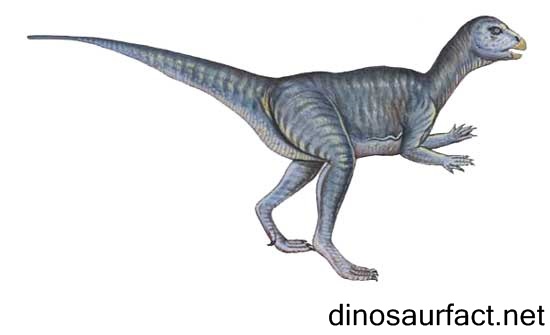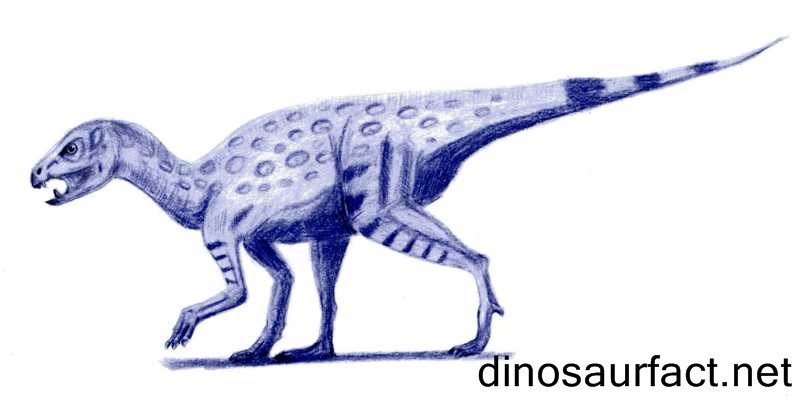 Click to visit the previous dinosaur bio
Click to visit the previous dinosaur bio
 |
|
 |
|
Kingdom: Animalia
Phylum: Chordata
SuperOrder: Dinosauria
Order: Ornithischia
Family: Heterodontosauridae
Genus: Abrictosaurus
 |
|
 |
|
 |
|

The Abrictosaurus was a dinosaur that lived in the early Jurassic period of the Mesozoic era. It was a tiny dinosaur not weighing more than 40 to 50 kilos. It was during the middle of the Jurassic period that the large, dominant dinosaurs were seen on the earth.
The Abrictosaurus was present on the planet about 200 to 195 million years ago. It is distinguished by the characteristic morphology of its teeth. Its teeth were developed to have more than one shape. This feature is not seen amongst the Triassic dinosaurs but is seen very commonly amongst the more evolved Jurassic dinosaurs.
The fossils of the Abrictosaurus were discovered in southern Africa. It could have existed on South America as well since Africa and South America was a single continent in the Jurassic period.
The Abrictosaurus belonged to order Orinithischia, which includes 'bird hipped' dinosaurs. It could walk on its hind legs, thus was bipedal. It derived its nourishment from plants and leaves.
Nomenclature
The word 'abricto' has Greek origins. It translates to 'wide awake' in English. The suffix '-saurus' is derived from the Greek word 'sauros' which means 'lizard' in English. Thus, the name 'Abrictosaurus' denotes 'a lizard that is wide awake'. This name was chosen because paleontologist Hopson, the scientist who suggested the name, firmly believed that the Abrictosaurus did not undergo spells of hibernation as suggested by other scientists.
The specific name Abrictosaurus consors was derived from the species name of the Lycorhinus consors. Hopson renamed the Lycorhinus to Abrictosaurus and retained the second part of the binomial name. The word 'consors' translates to 'consort'.
Discovery of fossils
- The fossils of the Abrictosaurus were excavated in the Upper Elliot Formation of southern Africa. Two sets of remains were discovered; one from Cape Province in South Africa and the other from Qacha's Nek in present day Lesotho.
- The remains found in Lesotho were discovered by scientist Richard Thulborn in 1974. He classified them as those belonging to genus Lycorhinus and ascribed them the specific name consors. He grouped the fossils found in South Africa as those of the Lycorhinus augustidens.
- Paleontologist James Hopson on his investigations of the fossils stated that the remains from South Africa did not match the Lycorhinus completely. On the heterodont teeth matched the Lycorhinus. Thus, he assigned a new name to the fossils, Abrictosaurus in 1975.
- Hopson later reclassified the Lesotho remains under his newly formed genus Abrictosaurus.
- Some teeth fossils found in Europe were also thought to belong to the Abrictosaurus; if not the Abrictosaurus then at least some other Heterodontosaurid. But they were later dismissed as non Heterodontosaurid.
- Thulborn refused to accept Hopson's inference. But most scientists presume the two to belong to separate genera. Apart from Thulborn and Hopton, no other paleontologists have written any papers about the two dinosaurs. Thus, there is no official record describing the taxonomic classification of the two remains.
Nature of fossils
The fossils of the Abrictosaurus showed very interesting details. The teeth were divided into sharper canine-like teeth along with the usual grinding teeth seen in other dinosaurs. These were most likely used for tearing their food.
But the most important feature was that the fossils from Lesotho lacked these canine-like teeth while those from Cape Province had them. This led Richard Thulborn to conclude that the remains from Qacha's Tek were of a female dinosaur. Such secondary sexual characteristics are seen amongst males of elephants. Thus Thulborn believed that he was observing gender differentiation in dinosaurs. This was the reason he named it the 'consort' of the Lycorhinus augustidens.
But opponents of this hypothesis have noted that the sacral bones of the Lesotho specimen were not joined together. Thus it could have been a juvenile dinosaur.
There isn't enough data available to corroborate the theories of either side. If this is indeed a case of sexual dimorphism, it is one of the very few instances in which it is seen amongst dinosaurs.
Current location of fossils
The two individual skeletons of the Abrictosaurus are preserved at University College London.
The Elliot Formation
- The Elliot Formation is a large geological structure sprawling in southern Africa. It includes South Africa and Lesotho. It is part of the Stomberg group of stratified rocks which in turn is a part of the Karoo basin super group.
- The Upper Elliot Formation is the upper region of the Elliot Formation. It was deposited later in history than the lower regions. Many ornithischian fossils were discovered in the Upper Elliot formation. These include the Heterodontosaurus and the Lycorhinus. Certain prosauropods such as the Massospondylus were also discovered here.
- The Elliot Formation consists predominantly of sandstone and limestone. They are red to brown in color and hence are called the African 'red-beds'.
Phenotypic features
- The Abrictosaurus was modest dinosaur growing to the length of 1 to 1.5 meters from head to tail.
- It weighed about 90 to 100 pounds.
- Its fore limbs were shorter than its hind legs.
- The Abrictosaurus had the ability to rip apart shrubs and bushes due to its canine like teeth. The position of the teeth at the base of the of the mandible indicated that it was an a primitive ornithischian.
- It also possessed a beak which assisted lifting its food in its mouth. The neck of the Abrictosaurus was moderately long.
- Its tail was very stout and long. Its legs were adapted for speed. It probably used this feature to evade its predators.
Habits and habitat
The Abrictosaurus most likely had herbivorous feeding habits like other heterodontosaurids. But an omnivorous lifestyle cannot be ruled out for it.
It scooped up its food with the help of its beak chewed it well with its maxillary teeth.
The habitat of the Abrictosaurus comprised of occasional ponds and lakes which dried up during the hotter months. It had abundant vegetation available during the rains.
Related and coexisting species
The Abrictosaurus is closely related to the Lycorhinus and the Heterodontosaurus, but most likely pre-dated both of them. It coexisted with many late Triassic and early Jurassic archosaurs and crocodilians and prosauropods. It could have lived alongside the African cousin of the Coelophysis, the Megapnosaurus.
Conclusion
The discovery of the Abrictosaurus was vital in getting scientists interested in the sexual differentiation among dinosaurs. It also displayed heterodont teeth, a feature not seen in the Triassic dinosaurs. The Abrictosaurus was a typical transitional species which paleontologists enjoy studying.
Index
Extinct Profiles
 Triassic Dinosaurs
Triassic Dinosaurs Jurassic Dinosaurs
Jurassic Dinosaurs Cretaceous Dinosaurs
Cretaceous Dinosaurs Pterosaurs
Pterosaurs Marine Reptiles
Marine Reptiles Dinosaur Extinction
Dinosaur Extinction